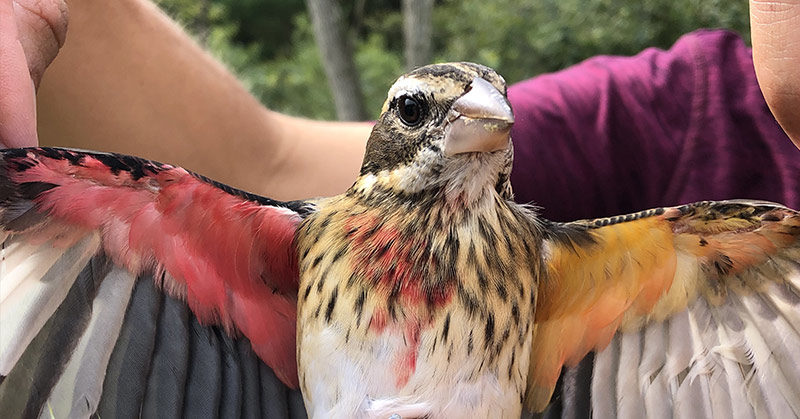A rare dual sex songbird has been discovered at the Carnegie Museum of Natural History’s Powdermill Nature Reserve in Pennsylvania. This once-in-a-lifetime bird sighting is as beautiful as it is rare. (1)
Dual Sex Songbird Spreads Its Wings
The Rose-Breasted Grosbeak is a gorgeous bird whether it is a female or male. The way you can tell is by the color of the feathers on the underside of its wings. (1)
For male birds, these feathers are usually a vibrant pinkish-red. The female birds’ feathers are warm, sunny yellow. (1)
This bird found by scientists in Rector, Pennsylvania, however, had both: Its right-wing is pink and its left-wing is yellow, making it a dual sex songbird. (1)
Bilateral Gynandromorphy
Gynandromorphy is a condition when animals possess both male and female characteristics divided down the middle of their bodies. Scientists believe that in birds it occurs from an error during egg formation. (2)
Unfertilized eggs usually contain just one sex chromosome: Either a Z or a W. Male birds are ZZ and female birds are ZW. In this extremely rare case, an egg develops with two nuclei that carry both – the Z in one and the W in the other. (1,2)
When the egg is fertilized and combined with Z-containing sperm, it creates an embryo that has some ZZ cells and some ZW cells, meaning that it will display both male and female traits. (1,2)
Read: Crows Are Capable of Conscious Thought, Scientists Demonstrate For The First Time
An Exciting Discovery
The scientists caught the dual sex songbird just in the way they catch all birds. (1) Delighted with their find, they recorded the bird’s (1):
- Sex
- Age
- Body measurements
They collected a couple of feathers for genetic analysis, took a few pictures, then released the bird back into the wild. (1)
“Every member of the banding crew expressed delighted surprise and joy in experiencing the banding of this rare bird,” said Powdermill’s Avian Research Center (ARC) bird banding program manager Annie Lindsay. (1)
Other Gynandromorphic Animals
This dual sex songbird isn’t the only animal that has experienced this genetic abnormality. Researchers have discovered several other gynandromorphic animals, including (1):
- Spiders
- Crustaceans
- Birds
- Butterflies
- Bees
They are extraordinarily rare, of course, which is what makes this find so special. Of course, there are many unknowns. For example, scientists don’t know if gynandromorphs are able to reproduce. (1)
“In female songbirds, the left ovary is the functional ovary, and because this bird’s left side is the female side, it may be able to produce viable eggs,” Lindsay explained. “However, the bird would also need to behave as a female to attract a male mate, and that isn’t something we are able to observe during normal banding operations,” (1)
This rare, dual sex songbird gives us an extra little peek into just how strange, wonderful, and beautiful our planet can be.

